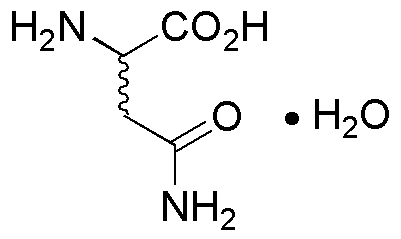DL-Asparagine monohydrate is widely utilized in research focused on:
- Cell Culture: This compound serves as an essential amino acid in cell culture media, promoting cell growth and viability in various biological research settings.
- Biotechnology: It plays a critical role in the production of recombinant proteins, aiding in the stability and solubility of these proteins during purification processes.
- Pharmaceutical Development: Used in drug formulation, it can enhance the bioavailability of certain medications, making it a valuable component in the pharmaceutical industry.
- Neuroscience Research: Asparagine is important for neurotransmitter synthesis, making it relevant in studies related to brain health and neurodegenerative diseases.
- Food Industry: It is utilized as a food additive, contributing to flavor enhancement and nutritional value in various food products.
General Information
Properties
Safety and Regulations
Applications
DL-Asparagine monohydrate is widely utilized in research focused on:
- Cell Culture: This compound serves as an essential amino acid in cell culture media, promoting cell growth and viability in various biological research settings.
- Biotechnology: It plays a critical role in the production of recombinant proteins, aiding in the stability and solubility of these proteins during purification processes.
- Pharmaceutical Development: Used in drug formulation, it can enhance the bioavailability of certain medications, making it a valuable component in the pharmaceutical industry.
- Neuroscience Research: Asparagine is important for neurotransmitter synthesis, making it relevant in studies related to brain health and neurodegenerative diseases.
- Food Industry: It is utilized as a food additive, contributing to flavor enhancement and nutritional value in various food products.
Documents
Safety Data Sheets (SDS)
The SDS provides comprehensive safety information on handling, storage, and disposal of the product.
Product Specification (PS)
The PS provides a comprehensive breakdown of the product’s properties, including chemical composition, physical state, purity, and storage requirements. It also details acceptable quality ranges and the product's intended applications.
Certificates of Analysis (COA)
Search for Certificates of Analysis (COA) by entering the products Lot Number. Lot and Batch Numbers can be found on a product’s label following the words ‘Lot’ or ‘Batch’.
*Catalog Number
*Lot Number
Certificates Of Origin (COO)
This COO confirms the country where the product was manufactured, and also details the materials and components used in it and whether it is derived from natural, synthetic, or other specific sources. This certificate may be required for customs, trade, and regulatory compliance.
*Catalog Number
*Lot Number
Safety Data Sheets (SDS)
The SDS provides comprehensive safety information on handling, storage, and disposal of the product.
DownloadProduct Specification (PS)
The PS provides a comprehensive breakdown of the product’s properties, including chemical composition, physical state, purity, and storage requirements. It also details acceptable quality ranges and the product's intended applications.
DownloadCertificates of Analysis (COA)
Search for Certificates of Analysis (COA) by entering the products Lot Number. Lot and Batch Numbers can be found on a product’s label following the words ‘Lot’ or ‘Batch’.
*Catalog Number
*Lot Number
Certificates Of Origin (COO)
This COO confirms the country where the product was manufactured, and also details the materials and components used in it and whether it is derived from natural, synthetic, or other specific sources. This certificate may be required for customs, trade, and regulatory compliance.


